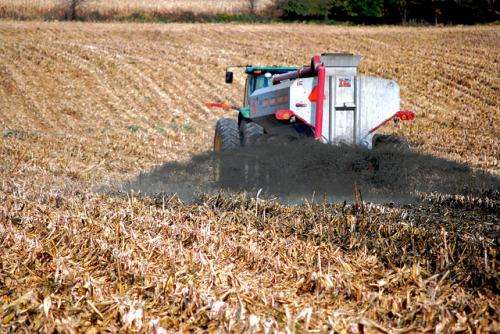Dr He says the research is the first to show the long-term effects of chemical fertilisers and manure on the nanoparticle (10-6 mm) scale. Credit: Chesapeake Bay Program
A UWA study has shown how long-term use of chemical fertilisers changes the soil on a nanoparticle scale and how these changes can be avoided by adding organic matter such as manure.
The research compared soil from a plot with no fertiliser to soil that had added chemical nitrogen, phosphorus and potassium fertiliser in the short-term (three years) and in the long-term (22 years).
The scientists also examined soil that had been treated with the chemical nitrogen, phosphorus and potassium fertiliser plus added pig manure.
UWA plant biologist and study co-author Xinhua He says two decades of pure chemical fertilisation destroyed the structure of the minerals in the soil.
He says when organic matter was added to the soil in the form of manure, it retained a make-up of nanominerals similar to that of the unfertilised soil.
"If you put some organic matter, you put some manure into the system, they will recover, they will retain this soil mineral structure," Dr He says.
The research, which used soil samples from experiments in China, is set to be published next month in the journal Chemosphere.
Research is the first of its kind
Dr He says government departments already encourage farmers to retain leaves and shoots in the soil to improve the soil structure.
But he says the research is the first to show the long-term effects of chemical fertilisers and manure on the nanoparticle (10-6 mm) scale.
"This [organic matter] is good, even at the very fine structure of the soil particles," he says.
The long-term soil samples were taken from an experiment on wheat and corn crops set up in 1990 while the short-term site was established in 2009.
The study showed only small changes to the soil following three years of chemical fertilisers and Dr He says it shows the importance of continuous funding for long-term studies.
He says research into ecosystem and agricultural function is important for future generations.
"We need the government to be supportive of this kind of long-term experiment," Dr He says.
He says the soil was analysed with a two-dimensional correlation spectroscope and a high resolution-transmission electron microscope.
He says further unpublished research on the 22-year-old sample from China and 160-year-old samples from Rothamsted Research in the UK showed similar results using NanoSIMS, a sensitive ion-microprobe housed at UWA that is the only facility of its kind in the southern hemisphere.
More information: Yongli Wen, Huan Li, Jian Xiao, Chang Wang, Qirong Shen, Wei Ran, Xinhua He, Quansuo Zhou, Guanghui Yu, "Insights into complexation of dissolved organic matter and Al(III) and nanominerals formation in soils under contrasting fertilizations using two-dimensional correlation spectroscopy and high resolution-transmission electron microscopy techniques," Chemosphere, Volume 111, September 2014, Pages 441-449, ISSN 0045-6535, dx.doi.org/10.1016/j.chemosphere.2014.03.078.
Journal information: Chemosphere
Provided by Science Network WA






















